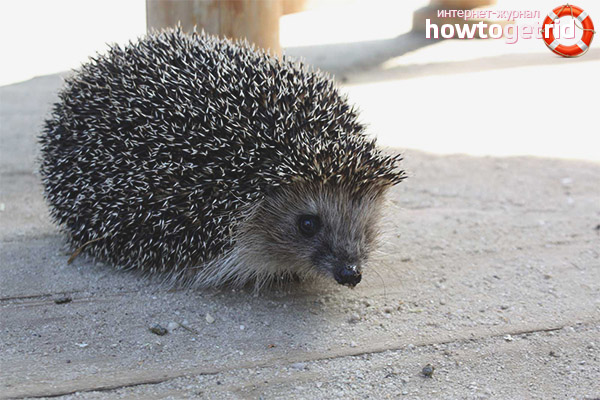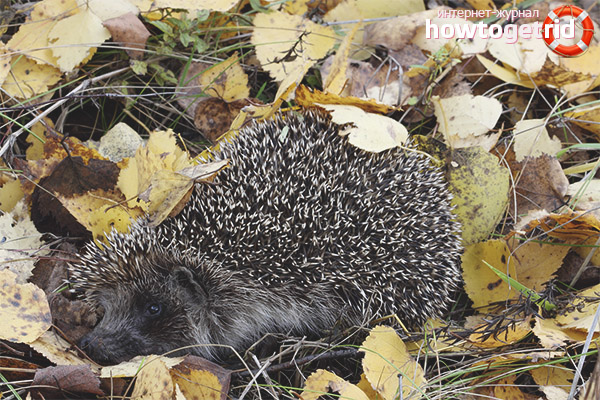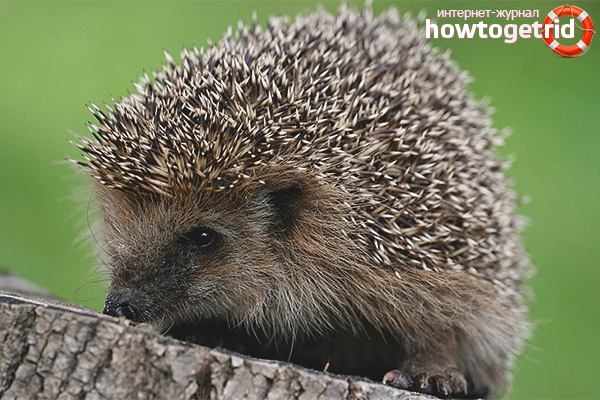The content of the article
Shy cute hedgehogs do not need additional presentation, because they are found everywhere. Thorny animals are successfully kept at home, sometimes people accidentally stumble upon hedgehogs in the forest or on the adjacent territory. In today's article, we will consider everything that affects these little spiny creatures. Literally, the name of the species translates as a thorny barrier. But let's not run ahead and reveal all the cards.
Description and Features
- To date, there are about 20 varieties of hedgehogs, all of them are partially similar, but also have differences. A distinctive feature is an elongated muzzle, a rounded and mobile nose, and a notch on the nose. The average overall features of the hedgehogs are 20 cm in length. The head is large enough, the eyes are round, resemble beads.
- Animals have poor eyesight in the daytime. However, they have excellent hearing, the same can be said about the sense of smell. The nose is mobile and wet, the ears are small with rounding. Contrary to popular belief, it is worth saying that hedgehogs with porcupines are not relatives. Hedgehogs are classified as moles and shrews. Also, one should not assume that any prickly creature has family ties with hedgehogs (as an example, sea urchin, there is nothing in common between them).
- An ordinary hedgehog refers to an animal that feeds on insects. By their weight criterion, animals weigh approximately 0.6-0.8 kg. Although there were more powerful representatives, whose mass reached 1.2 kg. Females are larger, males are smaller. The hind legs are long. They have 5 fingers with sharp claws.
- A fur coat of needles hides a small tail, which usually grows up to 3 cm. The upper part of the body is pigmented with light brown, the needles inside are empty, reach 3 cm in length. Each needle is considered to be riveted to the muscle fiber, which lowers or raises her. Every year, the needles gradually fall out, in their place another cover forms. It doesn't happen that a hedgehog gets rid of its prickly fur coat at a time. Everything happens systematically. Only those individuals who are sick get rid of needles.
- As for the number of needles, there are about 6.000 of them in adult representatives of the family and about 3.000 in young animals. Between the thorns is a short hairline, highlighted from above. In the abdominal part it is also light, but moderate, the head is slightly darker. Hedgehogs can be gray, solid, but this is rare. Also there are specimens with spots and a white belly.
- The peculiarities of individuals include folding into a lump when danger is brewing. This is possible due to the presence of ringed muscle fibers that stretch the skin. In this position, the animal can be long, until the threat disappears. Regarding the angle of growth of the needles, they stick out in different directions, but in general they look harmonious. Such an impregnable living com.
- Distribution affects several continents. Some of the population is dispersed throughout Eurasia, while other individuals live on the northern side of Africa. These individuals like forest strips, mixed plots, plains. They can be in thickets near the rivers, like steppe zones and wastelands. Try not to go deep into the coniferous massifs, as well as in wetlands.
- According to their natural characteristics, hedgehogs do not have the habit of marking ownership. They live in splendid isolation or in small groups. The territory is used exclusively for food searches.Often discussed family members are found near people’s housing, in park areas, near agricultural land, in orchards and in fields with wheat. Hedgehogs flee from their usual place due to frequent fires in the forest, as well as from a lack of food and human activity.
Lifestyle
- Individuals are awake at night. They lead a solitary existence, but at the same time they prefer to equip a house next to their comrades. When the sun sets, the period of searching for food begins. In the morning they return to the shelter and sleep. During the night, hedgehogs can overcome about 3 kilometers. They are very active when it is cloudy on the street.
- In the afternoon they curl up and sleep. They seek various shelters for themselves near bushes or trees. Lined with foliage and grass. They can find and choose for permanent residence the burrows of large rodents that have left their home. When they are engaged in self-construction, they dig minks with a diameter of 20 cm. They drag dry moss and grass as a litter.
- Hedgehogs cannot build their homes in the summer, so they choose a relatively safe area and live there. Females occupy an area of about 4-10 hectares, males require a large territory, so they take themselves 7-12 hectares. The older generation is feuding over territory, driving away strangers and even brothers. This is especially true of males.
- These individuals are distinguished by a well-developed sense of smell, hearing, but their vision is weak, especially in the daytime. When individuals are awake in pitch darkness, they find food by smell. Individuals swim well, they also jump normally. Some people think that hedgehogs cannot do this at all. Before placing any object on their thorns, hedgehogs lick it until saliva is released, then they are picked up and thrown up.
- It is worth noting that approximately in the middle of autumn, the earth begins to freeze gradually. In such a period, the main food is significantly reduced in the considered individuals. It was at this time that such animals began to actively prepare for hibernation.
- Most often, the animals in question try to equip large enough nests for the winter. Hedgehogs place them under the roots of trees, old stumps and heaps of deadwood. As soon as severe cold sets in, the animals hide in the shelter, closing the entrance tightly.
- In the house itself, hedgehogs burrow into a pile of fallen leaves. They curl up and fall into hibernation. Only in rare cases when the winter is really warm and snowless can you find a bewildered hedgehog that wanders around its hole.
- If someone does not know, the individuals in question use their needle cover to transport various building materials to equip their homes. Then the hedgehogs fall into hibernation.
- What remains interesting is that during winter hibernation in hedgehogs, the heart rate decreases to only a few beats per minute. In this case, blood pressure drops significantly. Body temperature at this moment is only 2 degrees!
- During the period of hibernation, the animal loses a third of its mass. The body gradually expends accumulated fat reserves. It is worth noting that such individuals are simply obliged to accumulate about 0.5 kg during the warm season. adipose tissue. Otherwise, during hibernation, they will die of starvation.
- Interestingly, after hibernation, animals are in no hurry to get out on the street. They are waiting for the moment when the air warms up to at least 14 degrees. After awakening, the individuals in question are very hungry. Therefore, they can go out in search of food both at night and during the day.
- It is noteworthy that with the advent of spring, molting most often occurs in such animals. The same process can occur in the fall. It is worth noting that molting is very slow. In a year, only 1 needle out of 3 is replaced by a hedgehog. At the same time, each one can take up to 1.5 years to grow.
Breeding
- Almost immediately after hibernation, mating games begin in such animals. Hedgehogs crawl out of the holes in warm weather, eat off and begin to search for a pair. It is noteworthy that quite serious fights unfold between males. Individuals constantly bite each other, push and use prickly needles. They snort loudly.
- Among other things, in spite of such cruel battles, animals do not suffer much. Often, the weaker male retreats and runs away. After the fighting ends, the male begins to care for the female. He constantly whirls around the chosen one and snorts softly.
- Such games most often last several hours. In the end, the female strongly presses the needles and the pair mates. Then the pregnancy lasts about 2 months. Before giving birth, the female arranges a separate nest for posterity. The bottom is lined with dry leaves and soft grass. As a rule, about 6 cubs are born.
- It is noteworthy that if someone finds a house with offspring, the female will transfer all the young animals to another safer place. Small hedgehogs are born completely helpless. After birth, needles appear in babies. Offspring are rapidly developing and growing.
Habitat
- Many believe that in European countries there are many hedgehogs. However, the number of individuals is decreasing every year. To date, most of the population is dispersed along the northern side of Africa. Representatives of the family are also found in Asia Minor, Western Europe, and northeast China.
- Individuals can successfully live on the western side of Siberia, the Caucasus, and Kazakhstan. They are not indifferent to the open spaces of New Zealand. Some individuals inhabit the Alps, climb to a height of 2 thousand meters above sea level. In these places they live next to dwarf pines.
- As for the area of distribution, hedgehogs can adapt to changes, so they are almost everywhere. They can only bypass wetland areas. They love to live near a person, they are often found in small towns and naively go out on the road.
- Individuals of this family seek glades, mixed stripes, and avoid dense coniferous forests. They are located at the edges, in copses, near the rivers. There are also many individuals in park areas and other cultivated areas. Representatives need to be sought in the grass, near sandy areas, in parks. They can equip their homes near the bushes, tearing out small indentations. They live near the roots of trees, sometimes they occupy abandoned burrows of rodents. When they go to seek food, they do not leave a long distance from the house.
Food
- The individuals under discussion are considered omnivorous; they are not picky in food. The main food source for hedgehogs are various insects, worms and slugs. Such individuals love to enjoy fruit and berry fruits. Sometimes they feed on cereal plants.
- Less commonly, these animals eat moss, acorns and mushrooms. With a lack of food, hedgehogs eat various food waste. Most often they find them in summer cottages. These animals rarely hunt vertebrates. Hedgehogs can attack numb reptiles or amphibians.
- Individuals who predominantly live in the northern part of the planet mainly feed on frogs, voles and shrews. Such mammals can often feast on chicks and eggs, whose bird nests are located on the ground.
- Separately, it is worth mentioning that the presented individuals are voracious. In just a day they can consume as much food, the mass of which will be equal to a third of their own weight. The interesting thing is that hedgehogs often attack bugs, bugs, and even vipers. The bottom line is that in the considered individuals, the body is not susceptible to dangerous poisons.
- Numerous studies have confirmed that hedgehogs have almost no reaction to opium, arsenic and hydrocyanic acid.Hedgehogs can be killed only by large doses of such substances. However, they do not reflect the amount of poison, which is deadly for large individuals.
Hedgehogs deserve special attention. They are quite interesting individuals. In the modern world, such individuals are often tamed and made pets. In captivity, they can easily live for about 10 years, and in freedom up to a maximum of 5 years.
Video: common hedgehog (Erinaceus europaeus)













Submit